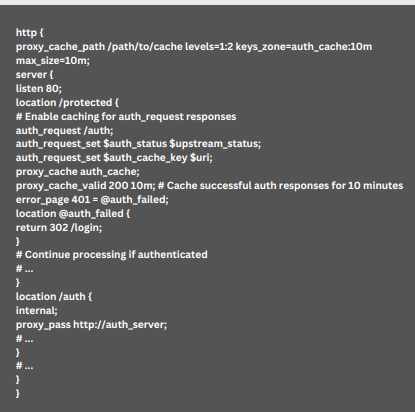Learn more about Nginx auth_request Cache from our experts. Our Nginx Support team is here to help you with your questions and concerns.
Nginx auth_request Cache | About & Benefits
Did you know that nginx auth_request cache refers to using caching mechanisms in the NGINX web server to store and reuse responses from the auth_request module?

In fact, the auth_request module in NGINX lets us carry out subrequests to an internal location for authentication and authorization purposes. Furthermore, setting up caching for auth_request responses can boost performance by lowering the number of repeated subrequests to the authentication server.
Let’s take a look at how it works:
- When the client sends a request to a protected resource, NGINX triggers a subrequest to an internal location designated for auth_request. Then, this subrequest is sent to an authentication server to decide if the client is authorized to access the resource.
- When the auth_request module gets a response from the authentication server, it can cache this response. Additionally, this is for a fixed duration according to the caching settings.
- Furthermore, for subsequent requests to the same protected resource, NGINX can use the cached auth_request response. This will not trigger a new subrequest to the authentication server. This cached response determines if the client can access the resource.
Benefits of implementing caching for auth_request responses
- Requests from the same client can be processed faster if the cached response can be used.
- Additionally, caching helps lower the load on the authentication server by avoiding repeated requests for the same client within the cache duration.
- Furthermore, caching lets NGINX to handle more client requests.
In order to configure caching for auth_request responses in NGINX, we can use the proxy_cache and related directives in our NGINX configuration. Here’s an example:

Here, proxy_cache_path defines the location and settings for the cache, and proxy_cache and proxy_cache_valid directives enable and configure caching for the auth_request responses. The cached responses are stored in the auth_cache zone and are valid for 10 minutes (proxy_cache_valid 200 10m).
[Need assistance with a different issue? Our team is available 24/7.]
Conclusion
Today, our Support Techs introduced us to Nginx auth_request Cache.
PREVENT YOUR SERVER FROM CRASHING!
Never again lose customers to poor server speed! Let us help you.
Our server experts will monitor & maintain your server 24/7 so that it remains lightning fast and secure.







0 Comments